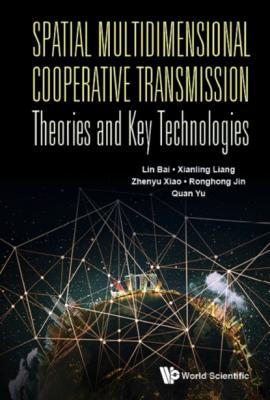Spatial Multidimensional Cooperative Transmission Theories And Key Technologies. Lin Bai
Читать онлайн.| Название | Spatial Multidimensional Cooperative Transmission Theories And Key Technologies |
|---|---|
| Автор произведения | Lin Bai |
| Жанр | Зарубежная компьютерная литература |
| Серия | |
| Издательство | Зарубежная компьютерная литература |
| Год выпуска | 0 |
| isbn | 9789811202476 |
Therefore, in the case where S0 and S1 are, respectively, established, the probability density of X is
And then the error probability in signal detection is
For the fixed signal energy Es, the error probability can be minimized when τ = –1, namely
It is easy to prove that the signal that minimizes the error probability has the opposite polarity, namely s0(t) = –s1(t). For the orthogonal signal set, τ = 0 and the error probability is
It can be seen from Eqs. (2.42) and (2.43) that the SNR between the orthogonal signal set and the signal set with the opposite polarity is 3 dB.
2.1.2.2M-ary signal detection
The detection problem of the binary waveform signal when M = 2 has been introduced above, and then we will analyze the detection problem of the M-ary signal.
It is assumed that in the M-ary communication, there is a set {s1(t), s2(t), . . . , sM(t)}, 0 ≤ t < T consisting of M signal waveforms. At this time, the data transmission rate is
In the case of M hypotheses, assuming that the received signal is R(t) = sm(t) + N(t), 0 ≤ t < T. The likelihood function and log-likelihood function of the L samples are expressed as
If the common terms in all hypotheses are ignored, the log-likelihood function becomes
Fig. 2.4. Maximum likelihood detector for M-ary signal detection based on a set of correlation detectors.
Using r(t) to represent the observed value of R(t), when L tends to infinity, the following equation can be obtained:
where
According to the expression of the log-likelihood function, the maximum likelihood judging criteria for accepting Sm should be log fm(r(t)) ≥ logfm′(r(t)) or
Based on the preceding conclusions, the process of connecting a series of correlation detectors to achieve the maximum likelihood judging criteria is shown in Fig. 2.4.
2.1.2.3Signal detection in vector space
In the process of wireless communication, in addition to receiving multiple target signals, the receiving end is also affected by the noise generated by the wireless channel and other devices. For these interferences, all of them are regarded as noise in the traditional signal combining method, which usually leads to a large performance loss. Considering this problem, the technology of signal detection in vector space is extensively studied to distinguish and detect target signals in mixed signals. Before introducing the signal detection in vector space, the expansion of space vector signal, namely Karhunen–Loeve Expansion, is first introduced.
The Karhunen–Loeve expansion can represent a function with the sum of multiple basis functions with different weights. Assume that there is a set {ϕl(t)} (l = 1, 2, . . . , L, 0 ≤ t < T) consisting of L orthogonal basis functions, and if the received signal can be decomposed into
then the coefficient sm,l in Eq. (2.47) is called the Karhunen–Loeve expansion coefficient. According to the characteristics of the orthogonal basis function,
Therefore, we can obtain
As shown in Eq. (2.47), if sm,l is known, then we can re-solve sm(t).
Define a vector sm = [s1,m s2,m · ·· sL,m]T. Obviously, sm and sm(t) are equivalent, where sm(t) represents the mth signal in the function space (or waveform space) and sm represents the mth signal in the vector space. Therefore, the energy of the two signals and the distance between the signals are both equal.
where dm,k represents the distance between the mth signal and the kth signal.
Using the Karhunen–Loeve expansion, we obtain
Define
where n =[n1n2 … nL]T. The noise signal can be expressed as
where
